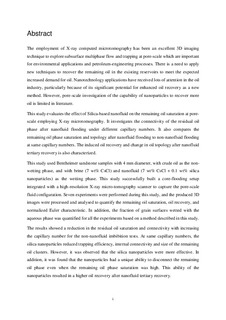| dc.description.abstract | The employment of X-ray computed microtomography has been an excellent 3D imaging technique to explore subsurface multiphase flow and trapping at pore-scale which are important for environmental applications and petroleum-engineering processes. There is a need to apply new techniques to recover the remaining oil in the existing reservoirs to meet the expected increased demand for oil. Nanotechnology applications have received lots of attention in the oil industry, particularly because of its significant potential for enhanced oil recovery as a new method. However, pore-scale investigation of the capability of nanoparticles to recover more oil is limited in literature.
This study evaluates the effect of Silica-based nanofluid on the remaining oil saturation at pore-scale employing X-ray microtomography. It investigates the connectivity of the residual oil phase after nanofluid flooding under different capillary numbers. It also compares the remaining oil phase saturation and topology after nanofluid flooding to non-nanofluid flooding at same capillary numbers. The induced oil recovery and change in oil topology after nanofluid tertiary recovery is also characterized.
This study used Bentheimer sandstone samples with 4 mm diameter, with crude oil as the non-wetting phase, and with brine (7 wt% CsCl) and nanofluid (7 wt% CsCl + 0.1 wt% silica nanoparticles) as the wetting phase. This study successfully built a core-flooding setup integrated with a high-resolution X-ray micro-tomography scanner to capture the pore-scale fluid configuration. Seven experiments were performed during this study, and the produced 3D images were processed and analysed to quantify the remaining oil saturation, oil recovery, and normalized Euler characteristic. In addition, the fraction of grain surfaces wetted with the aqueous phase was quantified for all the experiments based on a method described in this study.
The results showed a reduction in the residual oil saturation and connectivity with increasing the capillary number for the non-nanofluid imbibition tests. At same capillary numbers, the silica nanoparticles reduced trapping efficiency, internal connectivity and size of the remaining oil clusters. However, it was observed that the silica nanoparticles were more effective. In addition, it was found that the nanoparticles had a unique ability to disconnect the remaining oil phase even when the remaining oil phase saturation was high. This ability of the nanoparticles resulted in a higher oil recovery after nanofluid tertiary recovery.
Furthermore, the nanoparticles were significantly able to detach the oil phase from the grain surfaces as shown by the surface area index. The surface area indices evaluated for the nanofluid experiments were always higher compared to the non-nanofluid experiments at the same capillary numbers. | |
